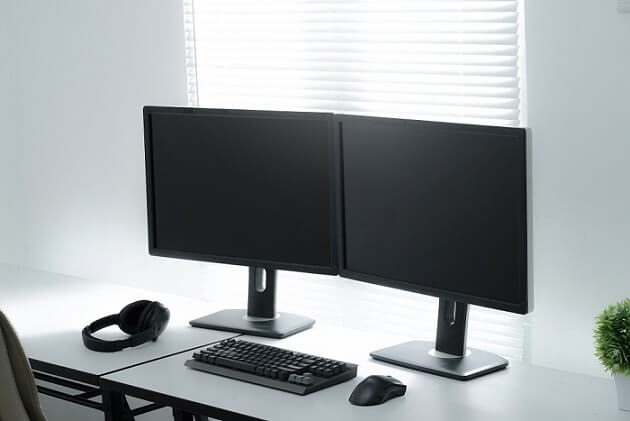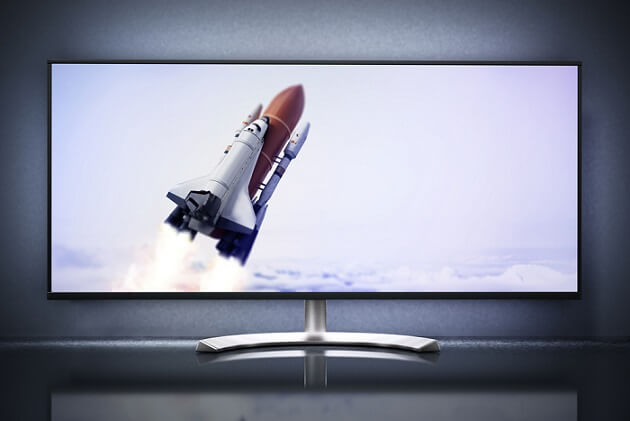People usually like to debate whether a dual monitor setup is a wise choice to make, or whether ultrawide monitors are good enough to use. For sure, both types of setups provide you with more screen space and allow you to do more productive stuff. Clearly, having a larger screen space allows you to work on multiple windows at the same time, hence, it’s both time-saving and convenient too.
So, if you own a desktop PC already, and want to upgrade your setup so that you can also have a larger screen space, which setup choice should you go with. We are sure that you might still be confused to choose between an ultrawide monitor or go for a dual-monitor setup. Well, if you have any doubts regarding that, this is the right page for you as we will be discussing what are the major differences these both types of setups have, and why one is a better option than the other one. Thus, if you are interested to know about it, make sure to read this article until the end.
Outline
ToggleAre Dual Monitors a Good Choice?

Moreover, dual monitor setups are highly customizable as you can adjust the orientation of your monitors and even place them either side by side, or you can set up one monitor over the other. So, as compared to a single screen, you get much flexibility in terms of adjustments.
In fact, you can even pair a high refresh rate monitor for gaming, with another monitor with good color accuracy and high resolution for other productive tasks. Hence, using dual monitor setups is truly a beneficial choice to make as it’s simply better in all terms if you compare it with a single monitor setup.
Dual Monitors: Pros and Cons
Pros:
- Multiple monitors can be placed in any screen orientation you wish.
- You can have two different monitors, suitable for different tasks such as gaming and video editing.
- Delivers extended screen space for productivity.
- Dual monitor setups work with laptops too.
- Developers can use one monitor in a vertical orientation for a better programming experience
- Ideal for streaming
- Improves your work performance and elevates your workflow
- Makes multitasking on a computer simpler
Cons:
- The middle bezel can be slightly distracting.
- You will need to adjust monitor settings separately
- Takes a lot of space on your work desk
- More costly than a single monitor setup
- Requires a powerful PC to handle the load of multiple displays running at once
Are Ultrawide Monitors Better?

As per the name, ultrawide monitors offer you more horizontal screen space, exactly what people try to achieve by using dual monitor setups. And, since ultrawide monitors overcome most of the limitations that dual monitor setups have, they are certainly better in most ways. However, if you are a programmer, you would definitely prefer a dual monitor setup as developers like working on a vertically oriented display more since it allows them to view more of their program code.
Apart from that, for all other tasks, ultrawide monitors are exceptionally good, because you can simply open multiple panels and windows on the same screen, without having to look at the distracting bezel right in the middle of the screen!
Ultrawide Monitors: Pros and Cons
Pros:
- Offers an extended horizontal screen space ideal for multitasking
- Eliminates the distracting middle bezel
- Highly convenient for running media editing software
- Color-calibrating is much more simpler
- Aspect Ratio is brilliant for watching movies
- Managing multiple windows is much simpler and seamless
- Cost-effective as compared to a dual monitor setup
- Doesn’t take much space on the desk
Cons:
- Not ideal for streaming
- Can not run multiple software in full-screen mode
- Not many high refresh rate monitor options available
Comparison Between Dual Monitors Vs. Ultrawide Monitors
Since both the dual monitor setups and ultrawide monitor setups have a lot in common, there are still a lot of factors to consider which make them differ from each other. If you are thinking of upgrading your computer setup, and confused about whether you should go for a secondary monitor, or have an ultrawide instead.
This quick comparison between the two will clear out all your doubts so that you can easily make a wise decision. In case you are building a PC from scratch, and do not know which type of monitor setup would work for you, this brief comparison between the two will clear out a lot of doubts that might be coming in your head.
1. Extended Screen Space on One Monitor
When comparing ultrawide monitors with a dual monitor setup, one of the greatest advantages or changes that you will feel is the extended screen space, that too on a single monitor itself. Yes, dual monitor setups do provide that too, but the fact that the middle bezel still remains as a big distraction there, an ultrawide monitor overcomes that quite nicely. In this way, if you use an ultrawide monitor instead of two monitors, you will have a much more seamless experience while moving around your mouse cursor as well as managing different tasks without having to look at a thick middle bezel.
2. Cinematographic Aspect Ratio
One of the biggest advantages that you will feel while using an ultrawide monitor is that the aspect ratio of 21:9 is quite adequate for watching movies, since most movies are shot in a wider format. Meanwhile dual monitor setups generally include two monitors of 16:9 aspect ratio. That said, if you think of watching a movie, you will be able to watch it on a single monitor only.
So, one disadvantage here is that you won’t be able to use the second monitor, hence, the screen space offered by the secondary monitor goes waste. Moreover, the single 16:9 monitor will also face letterboxing, so there will be black bars on the top and the bottom of your screen. So, as far as we compare ultrawide monitors with dual monitor setups, ultrawide monitors offer the best movie-watching experience without a doubt.
3. Consistency on Single Monitor Vs. Dual Monitors
Generally, in dual monitor setups, people use one high-end monitor for productive tasks like video editing or media consumption such as watching movies. Apart from that, the secondary monitor is usually just there to have some extra screen space.
However, if you want the monitors to have consistency in colors, and features, you will have to purchase two same monitors which can be highly expensive. Moreover, having two separate monitors will make you face issues like color differences, resolution differences that can be a huge problem if you use your setup for a lot of designing and graphical work.
On the other hand, ultrawide monitors are much better in this regard as you only have to deal with one display. Whether you want to calibrate the colors, change the brightness, or tweak any other setting, you can simply do it at once. However, on a dual monitor setup, you will have to adjust settings on each monitor separately which can be quite time consuming. So, ultrawide monitors are good as they save a lot of time, and eliminate all the limitations that you might face with dual monitors.
4. Management of Multiple Windows
It is for sure that if you have a multi-monitor setup, you will find no problems in adjusting and managing multiple windows on your overall screen space. You can simply drag and drop any important window on the other screen and work on two or more tasks at the same time.
However, it can be seamlessly done on an ultrawide monitor as well, thanks to the Windows Snap feature that is available in Windows 10, and 11 both. Using this feature, you can easily drag and drop windows on your ultrawide monitor and have them opened up in a mannered way side by side pretty conveniently. Hence, in this regard, dual monitors might have a slight edge, but ultrawide monitors are not at all bad either.
5. Ease of Use
If we compare dual monitors with ultrawide monitors, we feel that ultrawide monitors are much easier to set up and use. Since dual monitors take up a lot of your desk space, you will have to spend a lot of time to find the right positioning of both monitors. You can get some extra desk space if you use a hefty monitor arm that can handle both your monitors, but this is an extra add-on, which eventually makes your setup a lot more costly.
On the other hand, ultrawide monitors only take up desk space as much as any other single monitor would take. In addition, if you decide to change the brightness or change any other setting on the monitor, dual monitor setups take much time as you will have to change the settings on both screens one by one. And, matching the brightness and colors on two different displays is quite a hectic task. However, on a single monitor, you will feel more comfortable adjusting the settings. Thus, we can say that ultrawide monitors are a good pick.
6. Screen Size and Resolution
Generally, in dual monitor setups, if you don’t use the two monitors of the same size and resolution, you might have a bad experience. When two monitors are of different sizes and resolutions, if you try to drag any window from one monitor to another, the size and the appearance of the window abruptly changes which might not look good to all people. Well, managing the size of the displays is not possible if you have bought them already, you can correct this situation to some extent by using both the monitors at the same resolution.
On the other hand, the size and resolution are a major concern about ultrawide monitors too. Since ultrawide monitors have a larger footprint horizontally, you have to keep in mind the vertical height of the monitor as well. So, make sure to not choose any ultrawide monitor less than 34 inches. In terms of resolution, the standard Full HD 1920×1080 resolution is somewhat good for 16:9 monitors only.
But, in the case of ultrawide monitors where we have an extended screen space with an aspect ratio of 21:9, the Full HD 1920,1080p resolutions can’t do justice. On the other hand, 4K ultrawide monitors can be too expensive, which is not a practical option either if you are on a budget. That being said, you should go with ultrawide monitors that come with WQHD+ 3840 x 1600p resolution.
Conclusion:
As you might already know if you have read the article until this far, both the ultrawide monitors and dual monitor setups have their own advantages and disadvantages. We would say, until and unless you want a monitor that can be placed in the vertical orientation, for coding, or for streaming purposes, you should stick to an ultrawide. Yes, in our opinion, ultrawide monitors are a much better option to consider. It is because the ultrawide monitors are much more convenient to install, and they are typically less expensive as compared to a dual monitor setup.
On top of that, since an ultrawide monitor has a single screen, adjusting the settings of it will be a lot easier for you, and in fact, there will be no middle bezel to distract you in any way. Nowadays, you can even find ultra-wide monitors that are fit for gaming, so that’s not going to be an issue either. So, for those people who want an easy experience, and don’t necessarily need a vertical monitor, an ultrawide monitor is the best option for you.

